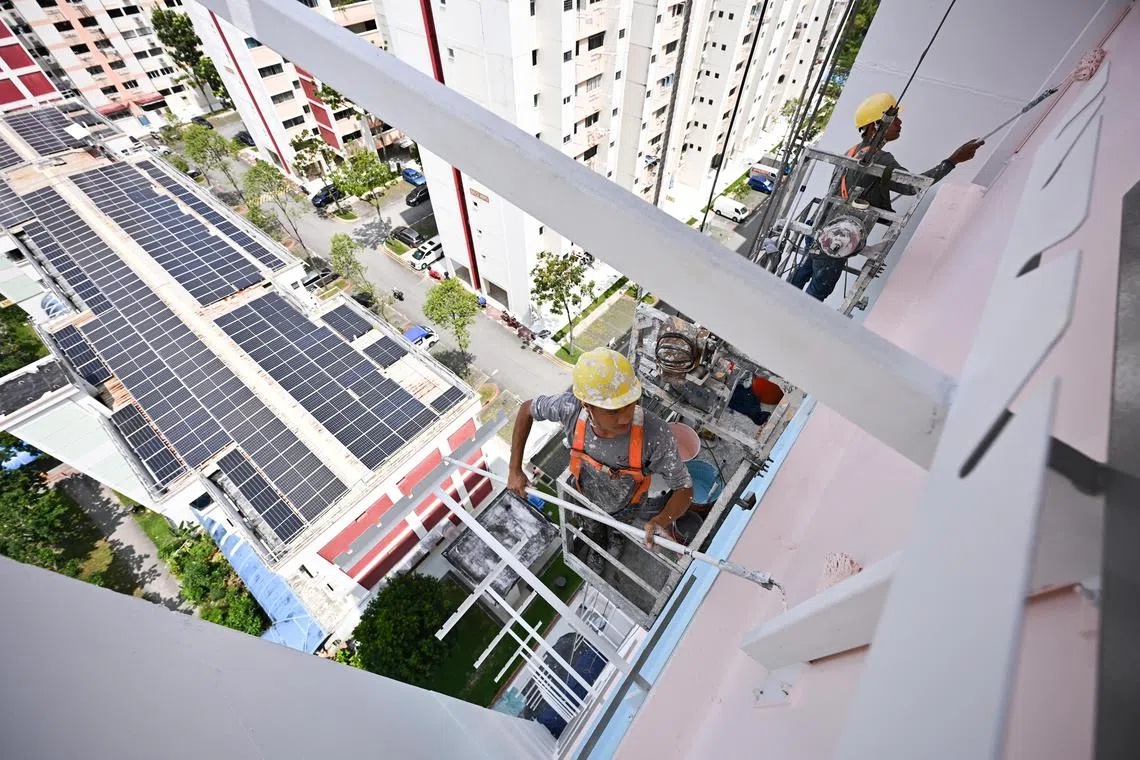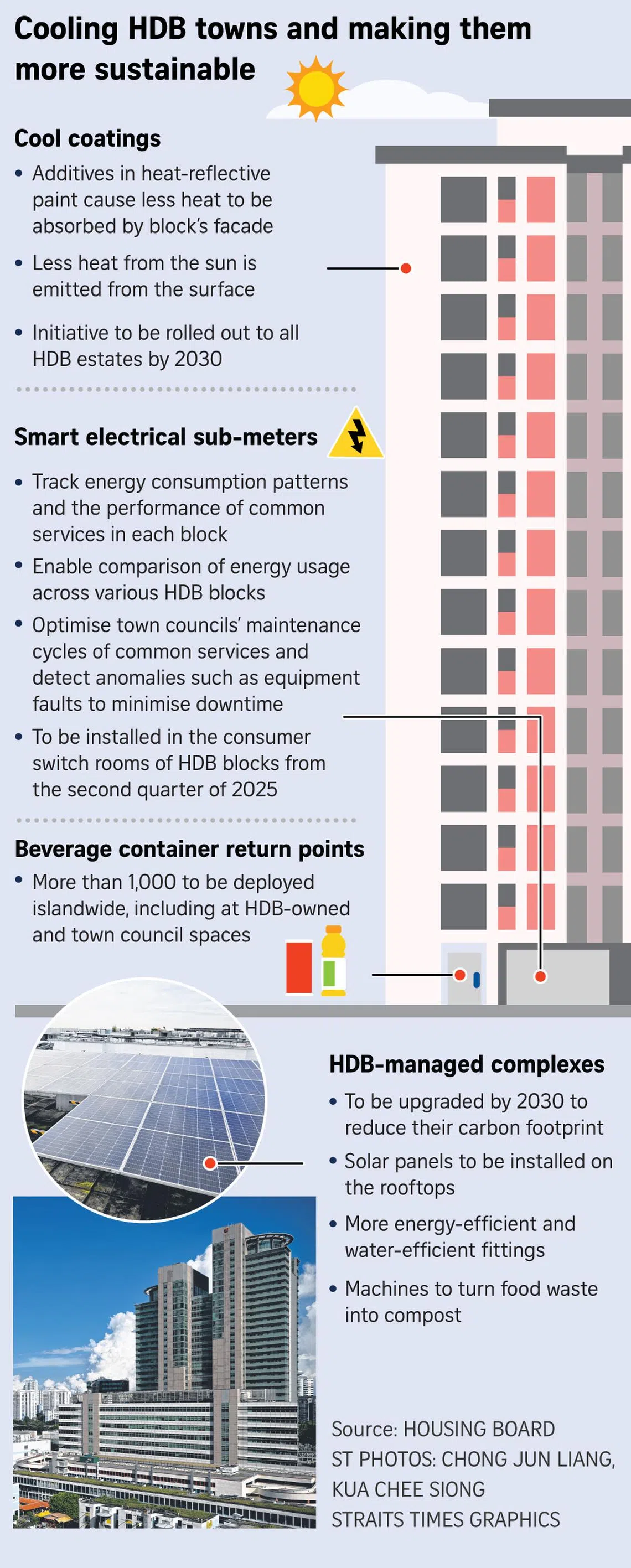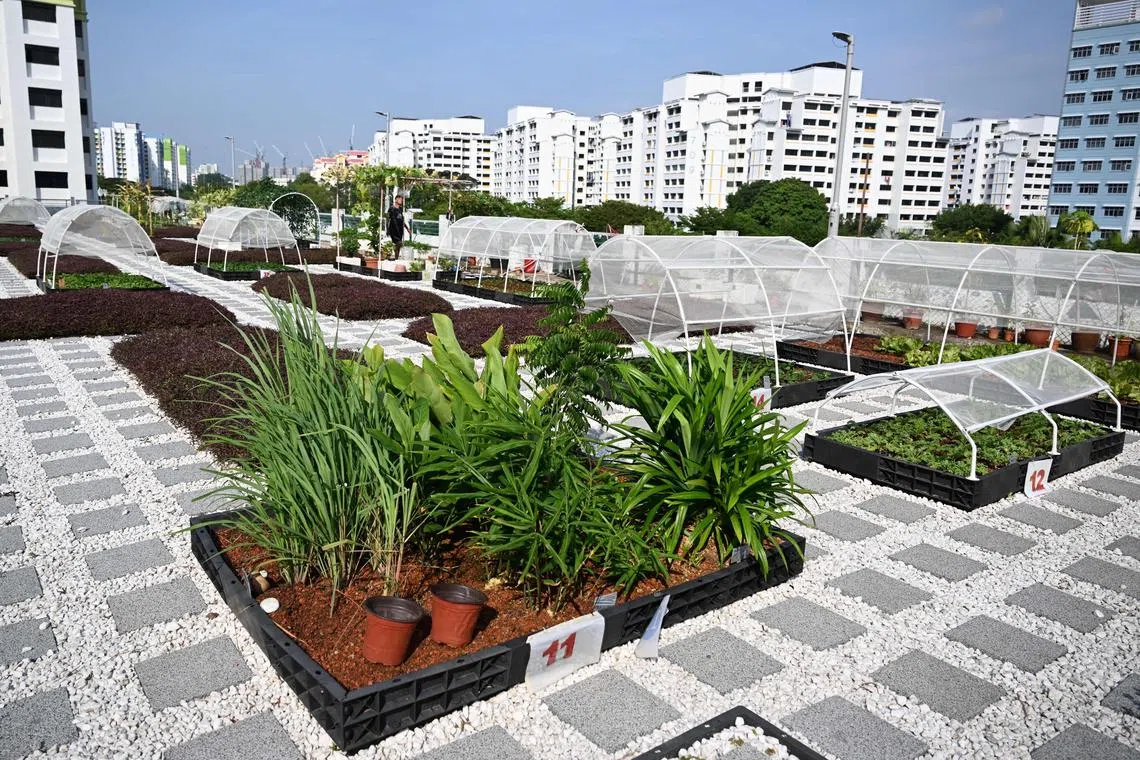Heat-reflective paint initiative to be rolled out to all HDB estates by 2030
Sign up now: Get ST's newsletters delivered to your inbox

The scheme to coat HDB blocks with heat-reflective paint will be offered to all town councils over the next five years, with the Government paying the extra costs from using the cool coatings.
ST PHOTO: LIM YAOHUI
Follow topic:
SINGAPORE – An initiative to coat Housing Board blocks with heat-reflective paint will be rolled out to all HDB estates by 2030, after a pilot project in Tampines showed that the cool paint reduced ambient temperatures by up to 2 deg C.
The scheme will be offered to all town councils over the next five years, with the Government paying the extra costs from using the more expensive cool coatings instead of conventional paint.
Senior Minister of State for National Development Tan Kiat How said on Feb 3 that scaling up this initiative to all existing estates will cost the Government an additional $60 million.
HDB said in a statement that public housing blocks will also be fitted with smart electrical sub-meters from the second quarter of 2025 to track energy consumption patterns and the performance of common services, such as lifts, lights and water pumps, in each block.
These are among new initiatives and updates to the Green Towns Programme that Mr Tan announced on Feb 3.
The scheme is a 10-year plan launched in 2020 to make existing HDB towns more sustainable and liveable by 2030 through cooling them, reducing energy consumption and recycling rainwater.
At a media visit to an HDB estate in Woodlands Drive 71, where several Green Towns initiatives have been implemented, Mr Tan said the programme has achieved good progress since it was launched five years ago, and that HDB will build on this foundation to step up its efforts to scale up the initiatives across HDB towns.
The expanded use of heat-reflective paint comes after a two-year pilot launched in 2021 by HDB and Tampines Town Council to apply cool coatings on the facades of some 130 HDB blocks in the estate. HDB said cool paint has been applied to 88 blocks, and painting for the remaining blocks is set to be completed by the end of 2025.

Senior Minister of State for National Development Tan Kiat How (right) and HDB executive engineer Toh Zi Ying at an HDB estate in Woodlands Drive 71, where several Green Towns Programme initiatives have been implemented.
ST PHOTO: CHONG JUN LIANG
Additives in cool paint reflect the heat from the sun to reduce surface heat absorption, and less heat is emitted as a result.
Apart from reducing the area’s ambient temperature, households in blocks painted with cool coatings also used less electricity as less energy from air-conditioners was needed to cool their flats, said HDB.
Meanwhile, data from the new smart electric sub-meters – to be installed in the consumer switch rooms of HDB blocks – will allow town councils to compare energy usage across HDB blocks and track the demand and supply for individual blocks in the estate.
The data collected will also help town councils optimise maintenance cycles of the common services, as well as detect anomalies such as equipment faults, to minimise downtime.
Another new initiative will see 38 HDB-managed complexes, such as Woodlands Mart and Loyang Point, upgraded by 2030 to reduce their carbon footprint.
Solar panels and water-efficient fittings will be installed at these complexes to reduce both energy and water usage by 10 per cent.
Machines that turn food waste into compost will also be installed to reduce waste by 30 per cent.

HDB aims to attain the Building and Construction Authority (BCA) Green Mark Super Low Energy (SLE) certification for four of its commercial complexes in 2025, before progressively rolling out green initiatives at an average of eight complexes a year.
The BCA Green Mark is a rating system to evaluate a building for its environmental impact and performance. An SLE project refers to a Green Mark building that saves at least 60 per cent of energy compared with 2005 levels, when the Green Mark certification was set up by BCA.
More than 1,000 beverage container return points will also be deployed islandwide, including at HDB-owned and town council spaces, to support the National Environment Agency’s beverage container return scheme.
Under the scheme, consumers will pay an extra 10 cents for bottled and canned drinks ranging from 150ml to 3 litres, but will receive a full refund of the deposit when they return the empty containers at designated return points.
In its statement, HDB provided an update on existing initiatives under the Green Towns Programme. These are a few of them (figures updated as at end-January 2025):
Greenery intensification: The top decks of 24 HDB multi-storey carparks have been installed with Prefabricated Extensive Green Roof Tray Systems and turned into green spaces such as community gardens.
Solar panels: More than 4,300 HDB blocks have been fitted with solar panels to power common services.
Elevator Energy Regeneration System: More than 500 lifts have been retrofitted with this system, which recovers the energy generated when lifts are moving and braking to power other services within the lift such as lighting.
Electric vehicle (EV) charging points: More than 3,600 EV chargers have been installed at 850 HDB carparks.
Woodlands resident Doreen Koh, 65, said the community garden on the rooftop of the multi-storey carpark at Block 671A Woodlands Drive 71 has made her estate more green and vibrant. The garden opened in April 2024.
“The garden has also brought me and my neighbours together to learn how to plant different vegetables, which we donate to low-income residents in the area,” said the accountant, who manages the garden with about 10 neighbours.
Wong Yang is a journalist at The Straits Times, covering housing, property, land use and community stories.

The community garden on the rooftop of the multi-storey carpark at Block 671A Woodlands Drive 71. It opened in April 2024.
ST PHOTO: CHONG JUN LIANG


